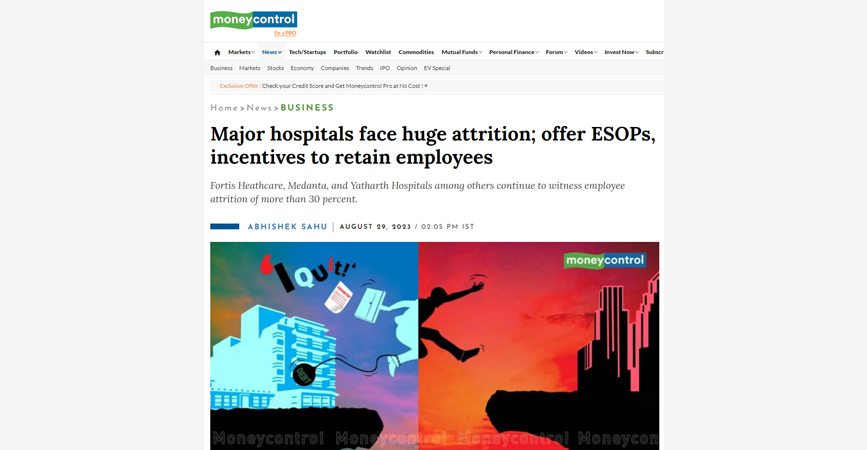
Fortis Heathcare, Medanta, and Yatharth Hospitals among others continue to witness employee attrition of more than 30 percent.
Other than nursing staff, WalkWater Talent Advisors has observed the next level of attrition is seen in the supporting functions like Finance & HR functions across major and small companies.
Hospitals in India are looking at various options to arrest the rising attrition in the healthcare industry, majorly concentrated among nurses.
Both permanent and temporary workforce demand remains high across major hospitals leading to rampant talent poaching among hospital majors. Fortis Healthcare, Medanta, and Yatharth Hospitals among others continue to witness employee attrition of more than 30 percent.
The high attrition is due to rapid expansion in the healthcare sector, which is growing at a CAGR of 16-17 percent and Niti Aayog expects it to reach $132 billion by the end of 2023.
While attrition among doctors is over 46 percent, it soared to around 74 percent among nurses at Yatharth Hospitals.
“….our attrition rate in fiscal 2023 was due to the operational nature of our business operations. We seek to attract highly qualified healthcare professionals and may face difficulties in negotiating favourable terms and arrangements with these professionals, the company said in a BSE filing.
Medanta has been witnessing an attrition rate of 35 percent for the last two years. “The turnover data includes turnover of nurses and junior doctors which is generally very high in the healthcare industry,” Medanta said in its latest annual report.
Medanta, Paras, Manipal and Apollo Hospitals did not respond to the queries on their retention strategy.
Though Fortis Healthcare’s overall annualised attrition improved by 1.5 percent in absolute terms, majorly owing to a 5 percent improvement for the nursing category, it is investing heavily in the retention part.
Focused retention
Since nurses and technicians comprise 70 percent of Fortis’ workforce, the healthcare firm ensures that the salaries are competitive and has recently started focusing on their development.
For the last two years, Fortis has been nominating nurses for healthcare management programs at the Indian School of Business (ISB) and Tata Institute of Social Sciences (TISS). These are full-time one-year programs. The attrition at this level for the nurses hovers around 60-65 percent, whereas Fortis is currently managing it at around 40-45 percent.
In addition, the company has long-term incentives (LTI) in the form of retention pay – an amount 2X times their CTC over three to five years.
“The hospital industry is seeing talent crunch day by day. For instance, to replace a nurse, we see several candidates. Many times these vacancies remain open. Secondly, there is no formal program which allows mid-career level people to get trained in hospital leadership roles,” Ranjan Pandey, Chief Human Resources Officer at Fortis Healthcare told Moneycontrol.
Currently, the hospital major is seeing a lot of poaching of the hospital heads from newly opened hospitals.
Yatharth Hospitals said that the limited supply of healthcare professionals may cause salaries and wages to rise which would lead to an increase in costs to recruit, retain and retrain these professionals.
“If we are unable to attract or retain medical personnel as required, we may not be able to maintain the quality of our services, which may adversely impact our revenue and reputation,” it said in a BSE filing.
Not just bellwethers
Other than nursing staff, WalkWater Talent Advisors has observed the next level of attrition is seen in the supporting functions like Finance & HR functions across major and small companies. Post-Covid, many employees have opted out to different industries where there is flexibility in working and hybrid models.
To arrest attrition, the average increment given across the sector is between 8 percent and 10 percent.
“Allocating ESOPs/stock options at senior levels and to the top performing talent is a growing trend visible in the industry,” said Prakash HS, VP of Pharma & Life Sciences at WalkWater Talent Advisors.
In a few other organisations, he said, LTIs are shared as an alternative to stock options where payout happens after completing the committed tenure in the organisation.
“We allow cross-functional growth, which helps employees from different streams to apply for a leadership role. We consider this as our USP. For mid and senior management, we look atLTI schemes including ESOPs,” said Rupali C Rane, HR Head, Nova IVF Fertility.
Part of Asia Healthcare Holdings (AHH) and one of the largest players in fertility treatment, Nova IVF Fertility promoted 11 percent of its employees to key roles this year and 42 percent of its Center Head positions (P&L Responsibility) are filled through an internal talent pool.
This is not a coincidence. Nova said it communicates the career path with the “high-flyers” (high performers) and also puts them in the position of responsibility for six months. Once they succeed in the expanded role, promotions are announced. Due to the strategy, the attrition among highflyers has gone down by 10 percent over last year.
“The recent developments have indeed brought some relief to the talent market but the healthcare sector in India still faces challenges in terms of skilled employee availability,” said Saras Malik, Chief People Officer at Artemis Hospital Gurgaon.
Nevertheless, the industry continues to keenly observe the talent market and adjust its strategies accordingly, acknowledging that the landscape is ever-changing.
Source: Money Control








